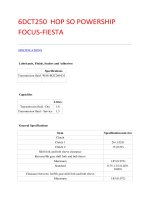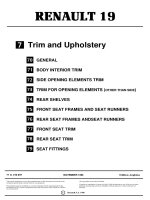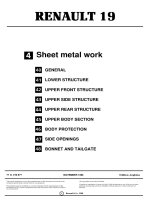Tài liệu hộp số xe ô tô FORD FOCUS và FORD FIESTA
Bạn đang xem bản rút gọn của tài liệu. Xem và tải ngay bản đầy đủ của tài liệu tại đây (4.77 MB, 144 trang )
6DCT250 HOP SO POWERSHIP
FOCUS-FIESTA
SPECIFICATIONS
Lubricants, Fluids, Sealers and Adhesives
Specifications
Transmission fluid WSS-M2C200-D2
Capacities
Litres
Transmission fluid - Dry 1.8
Transmission fluid - Service 1.5
General Specifications
Item Specification mm (in)
Clutch
Clutch 1 26 (1.023)
Clutch 2 15 (0.59)
Shift fork and hub sleeve clearance
Reverse/4th gear shift fork and hub sleeve
Maximum 1.85 (0.072)
Standard 0.75-1.25 (0.029-
0.049)
Clearance between 1st/5th gear shift fork and hub sleeve
Maximum 1.85 (0.072)
Standard 0.75-1.25 (0.029-
0.049)
Clearance between 3rd gear shift fork and hub sleeve
Maximum 1.725 (0.067)
Standard 0.625-1.125 (0.024-
0.044)
Clearance between 2nd/6th gear shift fork and hub sleeve
Maximum 1.725 (0.067)
Standard 0.625-1.125 (0.024-
0.044)
Synchronizer ring clearance, clearance between synchronizer ring
and flank surface of gear
Minimum 1.30 (0.051)
Differential Shim Selection Chart
Tool reading mm (in) Shim Thickness mm (in)
0.500-0.550 (0.0196-0.0216) 0.500 (0.0197)
0.551-0.600 (0.0216-0.0236) 0.550 (0.0217)
0.601-0.650 (0.0236-0.0255) 0.600 (0.0236)
0.651-0.700 (0.0256-0.0275) 0.650 (0.0256)
0.701-0.750 (0.0275-0.0295) 0.700 (0.0276)
0.751-0.800 (0.0295-0.0314) 0.750 (0.0295)
0.801-0.850 (0.0315-0.0334) 0.800 (0.0315)
0.851-0.900 (0.0335-0.0354) 0.850 (0.0335)
0.901-0.950 (0.0354-0.0374) 0.900 (0.0354)
0.951-1.000 (0.0374-0.0393) 0.950 (0.0374)
1.001-1.050 (0.0394-0.0413) 1.000 (0.0394)
1.051-1.100 (0.0413-0.0433) 1.050 (0.0413)
1.101-1.150 (0.0433-0.0452) 1.100 (0.0433)
1.151-1.200 (0.0453-0.0472) 1.150 (0.0452)
1.251-1.300 (0.0492-0.0511) 1.200 (0.0472)
Gear Ratio
Gear Ratio Final Drive Overall Ratio
Reverse 3.508 4.35 15.270
1st 3.917 3.89 15.254
2nd 2.429 3.89 9.459
3rd 1.436 4.35 6.250
4th 1.021 4.35 4.446
5th 0.867 3.89 3.375
6th 0.702 3.86 2.735
Transmission Description — Overview
General
The 6DCT250 is an electronically controlled 6-speed manual transmission which performs in
the same manner as a conventional automatic transmission while retaining the fuel efficiency
of a manual transmission. The 6DCT250 is equipped with two input shafts, a hollow and a
solid input shaft. Torque is transferred from the engine to the two input shafts via a dry
double clutch unit. There are two independent clutches in the clutch unit which are engaged
and disengaged by two clutch actuator motors and actuators. The clutch actuator motors are
controlled by the TCM. Having a double clutch and input shaft system enable the 6DCT250
to simultaneously select the next gear up or down depending on shift direction, providing
seamless shifting through the 6 forward gears. Gear selection is controlled by the TCM using
two integrated electric motors to rotate a series of gears and shift drums which in turn move
the shift forks selecting the appropriate gear. The TCM utilizes a number of sensors mounted
on the transmission and data received via the CAN to maintain the correct operation of the
transmission.
Transmission Description — Component Location
Item Description
1 Transmission Vent Assembly
2 Transmission Clutch Actuator Motor #1
Comments:
Gears 1st, 3rd and 5th
3 TCM
4 TR sensor
5 Transmission Outer Manual Lever
6 Transmission Halfshaft Seal
7 Transmission OSS Sensor
8 Transmission ISS Sensor #1
9 Transmission ISS Sensor #2
10 Transmission Clutch Actuator Motor #2
Comments:
Gears 2nd, 4th, 6th and R
Item Description
1 Transmission Fill Plug
2 Transmission Drain Plug
3 Transmission Halfshaft Seal
Transmission Description — System Operation and Component Description
System Operation
Overview
Item Description
1 Engine
2 Clutch unit
3 3rd, 4th, reverse and park gear output shaft
4 Input shaft (solid shaft) (1st, 3rd, 5th)
5 1st, 2nd, 5th and 6th gear output shaft
6 Differential
7 Input shaft (hollow shaft) (2nd, 4th, 6th, R)
In principle, the transaxle comprises two independent gear trains.
During driving, one gear train is always positively connected and the other set is already
engaged in the oncoming gear (although the clutch for this gear is still open).
Transaxle Design
Item Description
1 Input shaft (solid shaft) (1st, 3rd, 5th)
2 Output shaft (3rd, 4th, R and Park)
3 Differential
4 Final drive / ring gear
5 Input shaft (hollow shaft) (2nd, 4th, 6th and R)
6 Output shaft (1st, 2nd, 5th and 6th gear)
The name 6DCT250 stands for:
6 = Six gears
D = Dual
C = Clutch
T = Transaxle
250 = Torque (Nm)
This transaxle is regarded as a further development of the 6DCT450 PowerShift transaxle,
instead of utilising the "wet-running" (in fluid) plate assemblies of the clutch, the 6DCT250
features a compact dry dual system clutch.
Ford is installing the transaxle for the first time in the Fiesta (B299), model year 2010.5
(04/2010-) with 1.6L Duratec engine. It will be used universally in further vehicle lines.
The transaxle features two nested input shafts driven by a compact dry dual clutch system.
These two shafts are used in concert to provide seamless shifting through the six available
ratios with overdrive in the two top gears.
As each gear is selected, the appropriate clutch is activated to drive the vehicle. Each
consecutive gear is then preselected for the next "shift" operation as power is shifted from
one clutch to the other and back again whilst moving up and down through the individual
gears.
The 6DCT250 transaxle provides the smooth application of power as per the 6DCT450, but
with the advantages in efficiencies found only in a manual transaxle. By delivering power
with a dual "dry" clutch system, fluid volume is limited to less than 2 litres as compared to
the conventional automatic transmission.
The actuation of the clutch system is controlled by a dedicated computer through two
individual electronically driven clutch motor and actuator systems.
The selector lever has the following functions:
P - Park position
R - Reverse position
N - Neutral position
D - Electronic control of the transmission ratio using the TCM (Transmission Control Module)
If the selector lever is in the "P" position and the vehicle has been switched off, first gear and
reverse gear will be engaged via the TCM.
This results in a faster response after the starting process.
Special features of the transmission include:
6 gears plus reverse gear
Compact front transverse installation
Dry clutch
Internal electronic gearshift mechanism
Intelligent gear change control
Specification
Description Ford PowerShift (6DCT250)
Weight 73 kg
Rotational torque 250 Nm
Clutch Dry clutch
Gears Six forward gears, one reverse gear
Fluid specification WSS-M2C200-D2 (BOT350-M3)
World Manufacturer GETRAG Transmission GmbH
Dual Clutch Design
Item Description
1 Dual clutch unit
2 Clutch actuator 1
3 Guide tube
4 Clutch actuator 2
5 Engagement bearing
6 Retaining ring
Electronic clutch actuator motors are used to actuate each clutch in the transmission. The
motors work independently of each other.
The clutch actuators are independent systems within the clutch housing which apply an axial
force operating against the clutch diaphragm springs causing their respective clutch to
engage.
When a clutch is fully engaged, the clutch actuator motor provides the holding torque. During
disengagement the clutch actuator motor relaxes to it's rest position.
When engaged the applied force is directed back into the transmission through the hollow
input shaft; unlike a standard manual transmission, no thrust is applied to the engine
crankshaft.
A clutch 'touch point' position must be established by a learning algorithm within the system
software. Establishing the touch point is the system's method for ensuring that the clutch
actuation system is properly calibrated. This is necessary so that clutch engagement can be
controlled correctly by the transmission control module (TCM) and both engaged and
released steps are at the required torque capacity and within the required time.
Item Description
1 Flywheel
2 Pressure plate
3 Pressure plate
4 Friction disks
5 Pressure plate
6 Damper
7 Input shaft spline (solid shaft)
8 Input shaft spline (hollow shaft)
9 Friction disk
Operating principle of the transaxle
With the dual-clutch transaxle, gear (ratios) are engaged through the use of a dual multi-plate
clutch in combination with electro-hydraulic controls.
One of the multi-plate clutches is engaged in driving mode, the other is open allowing pre-
selection of the next gear ratio.
The clutch of the previously activated gear opens according to the accelerator pedal position
and request by the driver and simultaneously closes the other clutch in order to engage the
preselected gear.
The illustration shows the gearshift process in a manual transaxle
Item Description
1 Drive torque (Nm)
2 1st Gear
3 2nd Gear
The illustration shows that in conventional manual transaxles, gearshifts result in a customary
interruption of the propulsive force.
The illustration shows the gearshift process in a 6DCT250 transaxle
Item Description
1 Drive torque (Nm)
2 1st Gear
3 2nd Gear
With this gearshift, shown under load in the illustration, the power flow is only slightly
restricted; there is constant propulsion perceptible.
Torque path
NOTE: When looking at the illustrations, please note that the torque flows from the input
shaft once via the solid shaft and one via the hollow shaft.
1st Gear
The torque is introduced into the dual clutch via the flywheel. From there, the power is
transmitted via clutch 1 to the input shaft (solid shaft). The input shaft transmits the torque
to the first gear of the output shaft. The torque is transmitted to the differential via the output
pinion.
2nd Gear
The torque is introduced into the dual clutch via the flywheel. From there, the power is
transmitted via clutch 2 to the input shaft (hollow shaft). The input shaft transmits the torque
to the second gear of the output shaft. The torque is transmitted to the differential via the
output pinion.
3rd Gear
The torque is introduced into the dual clutch via the flywheel. From there, the power is
transmitted via clutch 1 to the input shaft (solid shaft). The input shaft transmits the torque
to the third gear of the output shaft. The torque is transmitted to the differential via the output
pinion.
4th Gear
The torque is introduced into the dual clutch via the flywheel. From there, the power is
transmitted via clutch 2 to the input shaft (hollow shaft). The input shaft transmits the torque
to the fourth gear of the output shaft. The torque is transmitted to the differential via the
output pinion.
5th Gear
The torque is introduced into the dual clutch via the flywheel. From there, the power is
transmitted via clutch 1 to the input shaft (solid shaft). The input shaft transmits the torque
to the fifth gear of the output shaft. The torque is transmitted to the differential via the output
pinion.
6th Gear
The torque is introduced into the dual clutch via the flywheel. From there, the power is
transmitted via clutch 2 to the input shaft (hollow shaft). The input shaft transmits the torque
to the sixth gear of the output shaft. The torque is transmitted to the differential via the output
pinion.
Reverse
The torque is introduced into the dual clutch via the flywheel. From there, the power is
transmitted via clutch 2 to the input shaft (hollow shaft). The input shaft now transmits the
torque to the reverse/2nd double gear which acts as an idler gear to reverse the direction of
rotation, this idler transmits torque to the reverse gear of the output shaft. The torque is
transmitted to the differential via the output pinion.
Park System
Item Description
1 Manual lever
2 Actuation shaft
3 Torsion spring
4 Park lock gear
5 Park lock pawl
There is a parking lock integrated in the second output shaft for safe parking of the vehicle
and to prevent it from rolling away when the parking brake is not applied.
The parking lock needs to be installed since the clutch actuators are not actuated when the
engine is switched off. The absence of power to the clutch actuators means that both clutches
are in the open position (normally open system).
Engagement on the park lock pawl (5) takes place exclusively by mechanical means. A
gearshift cable actuates the actuation shaft (2) when the transmission is placed into Park "P"
position via the selector lever. This causes the park lock pawl (5) to engage into a tooth gap
on the lock wheel (4).
When the park lock pawl (5) makes contact with a tooth in the park lock gear (4), a torsion
spring (3) at the actuation shaft is tensioned. When the vehicle moves, the tension of the
torsion spring (3) causes the park lock pawl (5) to engage in the next tooth gap in the park
lock gear (4).
DIAGNOSIS AND TESTING
Diagnosis By Symptom
General Equipment
Ford diagnostic equipment
Vehicle communication module (VCM)
Symptom Chart
Clutch Operation
Symptom Possible Sources Action
Harsh or
Soft/delaye
d
engagemen
t or shifts
Clutch Adaptive
Learn
Go to Clutch Adaptive
Learning.
Clutch REFER to Clutch Unit (307-
01B Automatic
Transmission/Transaxle —
Vehicles With: 6-Speed
Automatic Transaxle -
6DCT250, REMOVAL AND
INSTALLATION).
NVH in
1st, 3rd,
and/or 5th
Clutch 1 REFER to Clutch Unit (307-
01B Automatic
Transmission/Transaxle —
Vehicles With: 6-Speed
Automatic Transaxle -
6DCT250, REMOVAL AND
INSTALLATION).
Input Shaft 2 REFER to Transmission (307-
01B Automatic
Transmission/Transaxle —
Vehicles With: 6-Speed
Automatic Transaxle -
6DCT250, DISASSEMBLY).
NVH in
Park,
Neutral, R,
2nd, 4th,
and/or 6th
Clutch 1 REFER to Clutch Unit (307-
01B Automatic
Transmission/Transaxle —
Vehicles With: 6-Speed
Automatic Transaxle -
6DCT250, REMOVAL AND
INSTALLATION).
Input Shaft 2 REFER to Transmission (307-
01B Automatic
Transmission/Transaxle —
Vehicles With: 6-Speed
Automatic Transaxle -
6DCT250, DISASSEMBLY).
NVH in
1st, 2nd,
5th and/or
6th
Output shaft 1 REFER to Transmission (307-
01B Automatic
Transmission/Transaxle —
Vehicles With: 6-Speed
Automatic Transaxle -
6DCT250, DISASSEMBLY).
NVH in 3rd
and/or 4th
Output shaft 2 REFER to Transmission (307-
01B Automatic
Transmission/Transaxle —
Vehicles With: 6-Speed
Automatic Transaxle -
6DCT250, DISASSEMBLY).
NVH in all
gears
Differential REFER to Transmission (307-
01B Automatic
Transmission/Transaxle —
Vehicles With: 6-Speed
Automatic Transaxle -
6DCT250, DISASSEMBLY).
No PARK /
Stuck in
PARK
Selector lever
cable
adjustment
REFER to Selector Lever
Cable Adjustment (307-05B
Automatic
Transmission/Transaxle
External Controls — Vehicles
With: 6-Speed Automatic
Transaxle - 6DCT250,
GENERAL PROCEDURES).
Park
components
REFER to Transmission (307-
01B Automatic
Transmission/Transaxle —
Vehicles With: 6-Speed
Automatic Transaxle -
6DCT250, DISASSEMBLY).
Symptom Chart
Clutch Operation
Symptom Possible Sources Action
Harsh or
Soft/delaye
d
engagemen
t or shifts
Clutch Adaptive
Learn
Go to Clutch Adaptive
Learning.
Clutch REFER to Clutch Unit (307-
01B Automatic
Transmission/Transaxle —
Vehicles With: 6-Speed
Automatic Transaxle -
6DCT250, REMOVAL AND
INSTALLATION).
NVH in
1st, 3rd,
Clutch 1 REFER to Clutch Unit (307-
01B Automatic
and/or 5th Transmission/Transaxle —
Vehicles With: 6-Speed
Automatic Transaxle -
6DCT250, REMOVAL AND
INSTALLATION).
Input Shaft 2 REFER to Transmission (307-
01B Automatic
Transmission/Transaxle —
Vehicles With: 6-Speed
Automatic Transaxle -
6DCT250, DISASSEMBLY).
NVH in
Park,
Neutral, R,
2nd, 4th,
and/or 6th
Clutch 1 REFER to Clutch Unit (307-
01B Automatic
Transmission/Transaxle —
Vehicles With: 6-Speed
Automatic Transaxle -
6DCT250, REMOVAL AND
INSTALLATION).
Input Shaft 2 REFER to Transmission (307-
01B Automatic
Transmission/Transaxle —
Vehicles With: 6-Speed
Automatic Transaxle -
6DCT250, DISASSEMBLY).
NVH in
1st, 2nd,
5th and/or
6th
Output shaft 1 REFER to Transmission (307-
01B Automatic
Transmission/Transaxle —
Vehicles With: 6-Speed
Automatic Transaxle -
6DCT250, DISASSEMBLY).
NVH in 3rd
and/or 4th
Output shaft 2 REFER to Transmission (307-
01B Automatic
Transmission/Transaxle —
Vehicles With: 6-Speed
Automatic Transaxle -
6DCT250, DISASSEMBLY).
NVH in all
gears
Differential REFER to Transmission (307-
01B Automatic
Transmission/Transaxle —
Vehicles With: 6-Speed
Automatic Transaxle -
6DCT250, DISASSEMBLY).
No PARK /
Stuck in
PARK
Selector lever
cable
adjustment
REFER to Selector Lever
Cable Adjustment (307-05B
Automatic
Transmission/Transaxle
External Controls — Vehicles
With: 6-Speed Automatic
Transaxle - 6DCT250,
GENERAL PROCEDURES).
Park
components
REFER to Transmission (307-
01B Automatic
Transmission/Transaxle —
Vehicles With: 6-Speed
Automatic Transaxle -
6DCT250, DISASSEMBLY).
Diagnostic Parameters Identification (PID) Chart
NOTE: The following general PID list may be of use to the technician when exercising
output state control:
Accessing PIDs
PIDs PID Description
1stBLCK_GR_JMP 1st Gear Is Blocked Due To Gear Jump Occurred
1stBLOCK_TMP 1st Gear Is Blocked Temporarily Protect Mode
2ndBLCK_GR_JMP 2nd Gear Is Blocked Due To Gear Jump Occurred
2ndBLOCK_TMP 2nd Gear Is Blocked Temporarily Protect Mode
3rdBLCK_GR_JMP 3rd Gear Is Blocked Due To Gear Jump Occurred
3rdBLOCK_TMP 3rd Gear Is Blocked Temporarily Protect Mode
4thBLCK_GR_JMP 4th Gear Is Blocked Due To Gear Jump Occurred
4thBLOCK_TMP 4th Gear Is Blocked Temporarily Protect Mode
5thBLCK_GR_JMP 5th Gear Is Blocked Due To Gear Jump Occurred
5thBLOCK_TMP 5th Gear Is Blocked Temporarily Protect Mode
6thBLCK_GR_JMP 6th Gear Is Blocked Due To Gear Jump Occurred
6thBLOCK_TMP 6th Gear Is Blocked Temporarily Protect Mode
CLTC_A_BLCK Clutch A Actuator Blocked (a)
CLTC_A_CLOS_F Clutch A Reference Position Closed Failed
CLTC_A_CUR_MES Clutch A Actuator Current - Measured
CLTC_A_F_MANAG Clutch A Failure Management Status
CLTC_A_LOWCONF Clutch A Low Confidence In Sensed Position
CLTC_A_MTR_DSD Clutch A Actuator Motor - Desired
CLTC_A_OPEN_F Clutch A Reference Position Open Direction Failed
CLTC_A_POS_F Clutch Motor A - Position Sensor Fault
CLTC_A_SEQ_F Clutch Motor A - Phase Sequence Fault
CLTC_A_SLFDIAG Clutch A Self Diagnostic Procedure Status
CLTC_A_SLIPMES Clutch A Measured Slip
CLTC_A_SPRNG Clutch A Spring Cannot Fully Open Clutch
CLTC_B_BLCK Clutch B Actuator Blocked (b)
CLTC_B_CLOSE_F Clutch B Reference Position Closed Failed
CLTC_B_CUR_MES Clutch B Actuator Current - Measured
CLTC_B_F_MANAG Clutch B Failure Management Status
CLTC_B_LOWCONF Clutch B Low Confidence In Sensed Position
CLTC_B_MTR_DSD Clutch B Actuator Motor - Desired
CLTC_B_OPEN_F Clutch B Reference Position Open Direction Failed
CLTC_B_POS_F Clutch Motor B - Position Sensor Fault
CLTC_B_SEQ_F Clutch Motor B - Phase Sequence Fault
CLTC_B_SLFDIAG Clutch B Self Diagnostic Procedure Status
CLTC_B_SLIPMES Clutch B Measured Slip
CLTC_B_SPRNG Clutch B Spring Cannot Fully Open Clutch
CLTC_MTR_A_F Clutch Motor A - Phase Circuit Fault
CLTC_MTR_B_F Clutch Motor B - Phase Circuit Fault
CLUTCH_A_OPEN Clutch A Is Completely Open - Measured
CLUTCH_B_OPEN Clutch B Is Completely Open - Measured
FOOT_BRAKE Foot Brake - Foot brake state used by strategy
GEAR_CMD Gear Commanded
GEAR_ENGAGED Transmission Gear Engaged
GEAR_OSC Gear Command by Output State Control
GEARBX_SF_A_F Gearbox Error Status for Shift Fork A
GEARBX_SF_B_F Gearbox Error Status for Shift Fork B
ISS_A_PC_F Input Shaft Speed Sensor A - Power/Circuit Fault
ISS_A_RAW Input Shaft Speed A - Raw
ISS_B_PC_F Input Shaft Speed Sensor B - Power/Circuit Fault
ISS_B_RAW Input Shaft Speed B - Raw
ISS_EFFECT_RPM Effective Input Shaft Speed
OSS_PC_F Output Shaft Speed Sensor - Power or Circuit Fault
OSS_SRC Unfiltered Output Shaft Speed A
REVBLCK_GR_JMP Reverse Gear Is Blocked Due To Gear Jump Occurred
REVBLOCK_TMP Reverse Is Blocked Temporarily Protect Mode
RLC Reverse Lamp Control
RLC_F Reverse Control Lamp Status
SF_A_CURR_MES Shift Fork A Actuator Current - Measured
SF_A_ENGAG_STA Shift Fork A Engagement Control Status
SF_A_GRRAT_MES Shift Fork A Gear Ratio - Measured
SF_A_POS_MES Shift Fork A Actuator Position - Measured
SF_A_POS_STAT Position Signal Status for Shift Fork A Actuator
SF_A_POS_TARG Shift Fork A Actuator Position - Target
SF_A_ROTAT_MES Shift Fork A Rotational Position - Measured
SF_B_CURR_MES Shift Fork B Actuator Current - Measured
SF_B_ENGAG_STA Shift Fork B Engagement Control Status
SF_B_GRRAT_MES Shift Fork B Gear Ratio - Measured
SF_B_POS_MES Shift Fork B Actuator Position - Measured
SF_B_POS_STAT Position Signal Status for Shift Fork B Actuator
SF_B_POS_TARG Shift Fork B Actuator Position - Target
SF_B_ROTAT_MES Shift Fork B Rotational Position - Measured
SHFRK_A_CAL_E1 Self Calibration Error - Shift Fork A Movement
SHFRK_A_CAL_E2 Self Calibration Error - Shift Fork A Reference
SHFRK_B_CAL_E1 Self Calibration Error - Shift Fork B Movement
SHFRK_B_CAL_E2 Self Calibration Error - Shift Fork B Reference
SHFRK_NO_CAL_0 Self Calibration Prevented - Brake Input Status
SHFRK_NO_CAL_1 Self Calibration Prevented - Clutch A is Not Open
SHFRK_NO_CAL_2 Self Calibration Prevented - Clutch B is Not Open
SHFRK_NO_CAL_3 Self Calibration Prevented - Output Shaft Speed
SHFRK_NO_CAL_4 Self Calibration Prevented - Actuator Supply Voltage
SHFTLCK_ALLW Transmission Range Shift Lock Output Allow
SHFTLCK_ALLW_F Transmission Range Shift Lock Output Allow Status
SHIFT_A Shifting In Progress on Shift Fork A
SHIFT_B Shifting In Progress on Shift Fork B
TCIL Transmission Control Indicator Light
TCS_DEPRES Transmission Control Switch Pressed
TCS_STATE Transmission Control Switch Requested State
TR_A_DC Transmission Range Sensor Input A Duty Cycle
TR_A_POS_MEAS Transmission Range Sensor A Position - Measured
TR_A_UR Transmission Range Sensor Input A Unreliable
TR_B_DC Transmission Range Sensor Input B Duty Cycle
TR_B_POS_MEAS Transmission Range Sensor B Position - Measured
TR_B_UR Transmission Range Sensor Input B Unreliable
TR_CORRECTED Transmission Range Sensor Position - Corrected
TR_CRANK Transmission Range Input Allowing Engine Start
TR_CRANK_F Park Neutral Starter Enable Output Fault Detected
TR_SUPPLY_F Transmission Range Supply Voltage Output Fault
TRAN_RAT Transmission Gear Ratio
Diagnostic Trouble Code Charts
General Equipment
Ford diagnostic equipment
Vehicle communication module (VCM)
Diagnostic Trouble Code (DTC) Chart
Five
Digit
DTC Description Condition Symptom Action
P06A
6
Sensor Reference
Voltage A Circuit
Range/Performan
ce
Input shaft speed
sensor 1 power
supply circuit
failure
Disabled 3rd and 5th
gears. Only engage
in 1st gear at a stop.
Neutral shift drum 1
after launch.
REFER to Pinpoint Tests
- OSC Equipped Vehicle
(307-01B Automatic
Transmission/Transaxle
— Vehicles With: 6-
Speed Automatic
Transaxle - 6DCT250,
DIAGNOSIS AND
TESTING).
and GO to Pinpoint Test
C.
P06A
7
Sensor Reference
Voltage B Circuit
Range/Performan
ce
Input shaft speed
sensor power
supply circuit
failure
Disabled 2nd, 4th
and 6th gears.
Neutral shift drum 2
in forward range.
REFER to Pinpoint Tests
- OSC Equipped Vehicle
(307-01B Automatic
Transmission/Transaxle
— Vehicles With: 6-
Speed Automatic
Transaxle - 6DCT250,
DIAGNOSIS AND
TESTING).
and GO to Pinpoint Test
C.
P06A
8
Sensor Reference
Voltage C Circuit
Range/Performan
ce
Output Shaft
Speed (OSS)
power supply
circuit failure.
Substitute ABS
wheel speed, input
shaft speed sensor 1
or input shaft speed
sensor 2 for OSS.
REFER to Pinpoint Tests
- OSC Equipped Vehicle
(307-01B Automatic
Transmission/Transaxle
— Vehicles With: 6-
Speed Automatic
Transaxle - 6DCT250,
DIAGNOSIS AND
TESTING).
and GO to Pinpoint Test
C.
P070
1
Wrong Engine
Control fault -
monitors the
torque up and
engine speed
requests from the
Transmission
Control Module
(TCM), if it finds
a fault it turns off
these requests
Transmission
Control System
Range/Performan
ce
Turn off
transmission torque
up requests
See more specific DTC.
If no other DTCs are set,
clear code and re-test.
P070
2
Transmission
Control System
Electrical
Sets with P0882
(voltage out of
range low) or
P0883 (voltage
out of range high)
See more specific
DTC.
Adjust Selector Lever
Cable. REFER to
Selector Lever Cable
Adjustment (307-05B
Automatic
Transmission/Transaxle
External Controls —
Vehicles With: 6-Speed
Automatic Transaxle -
6DCT250, GENERAL
PROCEDURES).
If concern still present,
replace TR sensor.
P070
6
TR Sensor A
Circuit Range/
TR sensor A
frequency out of
Default to
NEUTRAL
REFER to Pinpoint Tests
- OSC Equipped Vehicle









